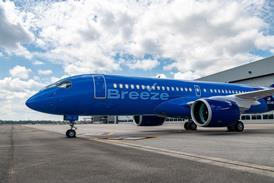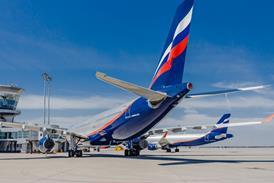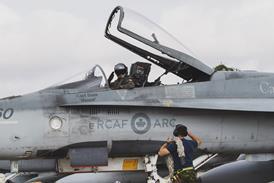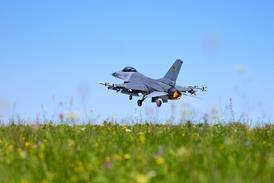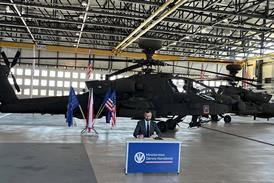Andrew Doyle/LONDON
AS AIRCRAFT MANUFACTURERS continue to search for ways of cutting the life-cycle costs of their products, so-called "more-electric" technology is finding an increasing number of applications in the industry. With an "all-electric" aircraft as the ultimate goal, engineers believe that these initial steps could be the tip of the iceberg.
In simple terms, a more-electric aircraft uses electrical power to drive secondary mechanical systems, instead of a combination of hydraulic, pneumatic and electrical power. An all-electric aircraft would have no centralised hydraulic or pneumatic systems at all.
CUTTING AIRFRAME WEIGHT
The reason that more-electric technology is attracting the interest of aerospace engineers is that its use could eventually reduce the empty weight of a typical airliner by around 10%, with a similar reduction being achieved in fuel consumption. The number of moving parts in the aircraft could also be reduced, which would result in reliability being boosted and maintenance costs lowered. At the heart of a more-electric aircraft lie more-electric engines, the sources of all power for the aircraft's systems during flight. Existing engines provide this power through an external accessory gearbox, which is driven by a mechanical drive shaft, usually from the low-pressure (LP) turbine.
The external gearbox, in turn, drives electrical generators and hydraulic pumps (pneumatic power is already supplied as bleed from engine compressors). The electrical generators are traditionally of the variable-speed/constant frequency type, although variable-frequency generators which do not require a constant-speed drive mechanism have been introduced on aircraft such as the Bombardier Global Express business jet. (Solid-state electronics are then used to regulate the frequency of the power supply.)
The problem is that many of the accessories driven by this gearbox require power only intermittently. For example, hydraulic power for extending and retracting the wing flaps and raising and lowering the undercarriage is only required during take-off and landing. This results in poor use of power systems.
In addition, the electrical, hydraulic and pneumatic drive systems each have to be sized for the maximum load which they are likely to encounter. If a single type of power, ie, electrical, was used for all the secondary systems, the overall maximum load case would be significantly reduced, assuming that each individual system does not require its maximum power input at the same time. The result would be more compact, and lighter, power systems, capable of better matching of available output to demand.
MOVING ACCESSORIES
Furthermore, the accessories driven by the engine's external gearbox could then be moved out of the nacelle altogether. They could be placed in less environmentally demanding locations in the airframe, as they would require only an electrical supply, instead of a mechanical drive or hydraulic pressure. Taking the concept a stage further, engineers believe that the engine's external gearbox could be eliminated altogether. This in turn would yield a whole series of additional benefits in terms of engine performance.
To achieve this target, engine manufacturers are studying compact motor/generators, which would be buried within the engine itself. Using so-called switched-reluctance motor/generators, located on the engine shaft, is one possible solution under consideration. One benefit is that the increased availability of electrical power could allow greater use of electromagnetic or "oilless" bearings.
"That's an idea that is being studied in Europe," says Mike Gainsford, chief of advanced controls engineering at Rolls-Royce. "One of the things that will make a business case for doing it is electromagnetic bearings. We are really only at the fringes of these studies. We are saying: 'yes it looks like there may be benefits to be had'", he adds.
While electromagnetic bearings would dramatically reduce friction, they would consume a lot of electrical power, however, and require sophisticated cooling systems.
Gainsford says that switched-reluctance motor/generators and electromagnetic bearings are "-so strongly coupled that we are trying to integrate both technologies into an overall study. When you have the electricity around for electromagnetic bearings, you start to get synergies."
Removing the gearbox would reduce loads on the engine, boosting fuel efficiency. It would also improve the engine's performance during ground starting and re-lighting during flight, and simplify engine removals because only a small number of electrical connections would have to be disconnected.
EASIER MAINTENANCE
More-electric aircraft would be easier to maintain, because of the elimination of hydraulic and pneumatic systems and a network of databases could be used to perform integrated fault diagnostics. The use of standard components, such as actuator motors, throughout the aircraft would also assist in cutting down on spares.
Systems such as the flying controls, flaps, slats and undercarriage would be powered by compact electric motors or hydraulic pumps, and would respond more quickly than those powered by a traditional hydraulic system.
Even anti-icing would be carried out by electro-impulse or electro-thermal systems, instead of using bleed air from the engines, and the cabin environmental-control system (ECS) would also be electrically powered. This would be most advantageous in aircraft powered by engines with relatively high bypass-ratios, where less bleed air for anti-icing and ECS systems is available.
"Studies show that the potential seems to be there," says R-R's Gainsford, "but we need the airframers to do a lot of study work, such as into what is the best way for them to move electrical power around the aircraft." A study conducted by NASA has demonstrated that all of the benefits of more-electric technologies would add up to substantial savings for airlines. It takes the example of a Boeing 767-sized aircraft carrying 200 passengers, or a 17,700kg payload, over a range of 3,700km (2,000nm), and calculates that an equivalent all-electric aircraft would have a 10% lower empty weight and consume 9% less fuel.
It determines that the aircraft's secondary power system would be about 1,360kg lighter, with a further 680kg saving contributed by an all-electric flight-control system.
TECHNICAL PROBLEMS
There are, however, significant technical problems to be overcome before the technology can be put into widespread use. To keep the weight of the electrical system down to an acceptable level, higher voltages than the industry-standard 115V AC would have to be used.
Use of around 270V DC would allow conductor sizes to be reduced, thus minimising the weight of the system. High-voltage DC can cause both arcing and undesirable electromagnetic effects when devices are being switched on or off. The necessity to screen certain components from electromagnetic interference, and keep them cool, could add weight to the airframe.
The more-electric aircraft would also have a new role for auxiliary power units (APUs). If the main engines no longer provided pressurised bleed-air for the cabin environmental-control system, this may have to be sourced from a continuously operated APU. All of the aircraft's other systems would also be reliant on the availability of electrical power.
"APU suppliers would have to develop APUs that are dispatch critical," says R-R's Gainsford. "You may need redundant APUs because you have to guarantee an electrical supply. You may have to put two to three APUs on the aircraft," he adds. Removing the engine bleed-air system would improve the efficiency and handling of the main engines.
UK companies which are involved in more-electric studies, such as Lucas Industries, R-R and Smiths Industries, have met to discuss funding issues under a Society of British Aerospace Companies initiative. It is clear that, as more-electric technology affects almost every aspect of aircraft design, teamwork is going to be essential if it is to be implemented successfully.
"Various companies are beginning to realise it's going to be the technology of the future," says R-R's Gainsford.
"The realisation is dawning that we need a concerted effort. We are generally aware of what is happening in the field and we would like to get involved in some studies," he adds. "The whole industry has got to move together," Gainsford concludes.
Source: Flight International

